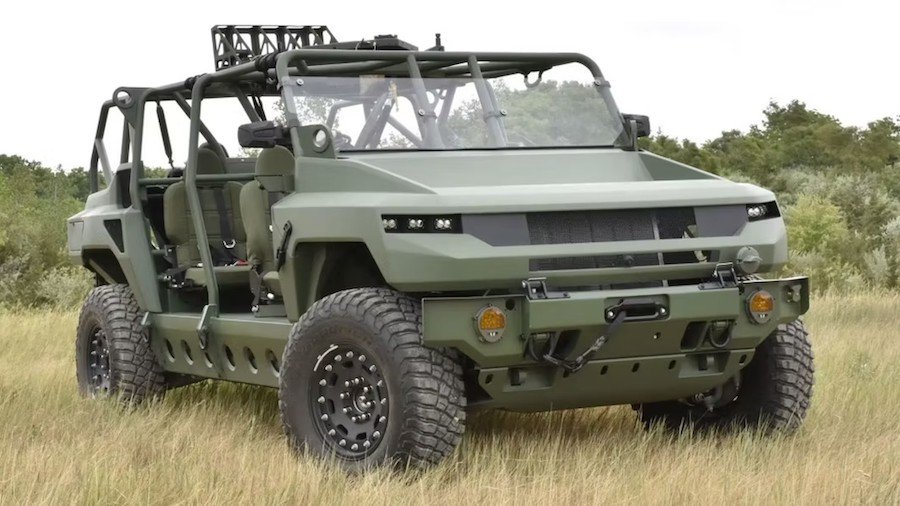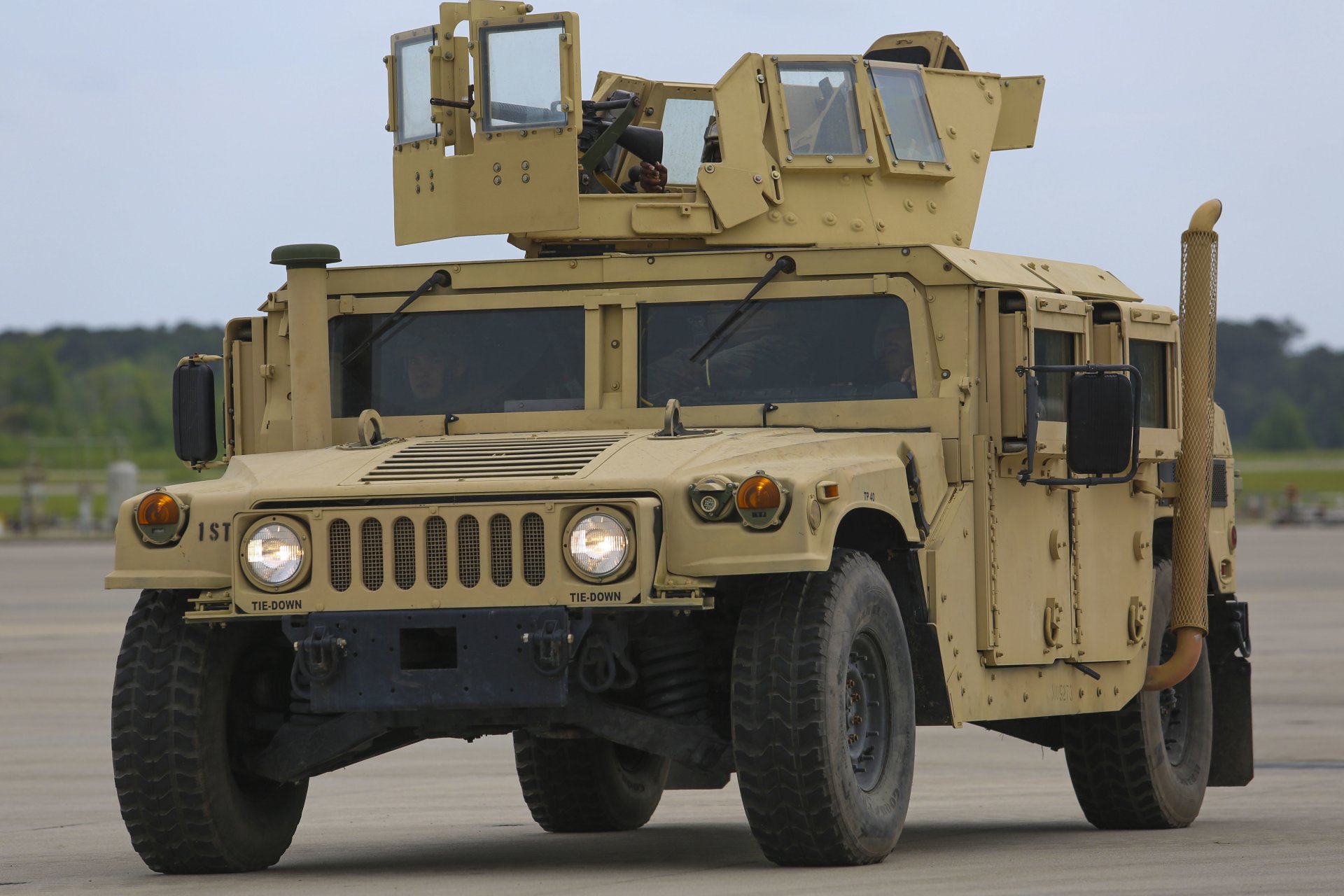The GMC Hummer EV Doesn’t Need To Exist, but Its Militarized Cousin Sure Does

If you promised yourself you'd buy a GMC Hummer EV as soon as one hit showrooms when it was revealed in 2020, please don't take offense to these words. This editorial isn't aimed at any of you. Instead, if you were salivating over the coming 3X trim package for the civilian Hummer EV, we found something that, to our minds, is even cooler and far more historically significant. It's still a bit weird in its execution, being inspired by a civilan off-roader and not the other way around.
Meet the General Motors Defense eMCV, short for Electric Military Concept Vehicle. In a world of diesel HUMVEES and even bigger MRAPs, GM appears dead-set on proving the military-industrial complex won't be exempt from the all-electric revolution the way you might think it is. Of course, the last reserves of that sweet-sweet dino-juice will assuredly be put in the hands of the military and public service vehicles. Still, even their supply of petrochemicals is finite. When the day comes when that supply runs out, don't be surprised if the world's military ground vehicles start to take on a similar form.
But instead of mindlessly mouthing off a spec sheet without a more holistic overview of the circumstances behind the eMCV's creation, let's take a different approach. Instead, let's look at the different context behind the civilian and military Hummers designed 30 years ago to what GM has on offer in the 2020s. As you'll find, the impetus behind their respective creations is more or less the polar opposite of each other. Of course, most petrolheads know the story behind the original Hummer H1 and its military cohort, the Humvee.
It was an easy choice for the U.S. Military to replace its aging fleet of Vietnam-era jeeps and other various light trucks with the Humvee starting in the mid 80s. Of course, the Pentagon spent years combing through all sorts of designs, including one from Lamborghini of all people, before settling on the proposal submitted by AM General, then a subsidiary of American Motors Corporation. It was only when the biggest movie star on the planet, Arnold Schwarzenegger, observed a formation of Army Humvees rolling down a California highway that he reached out to AM General to procure a civilized variant for himself.
With this in mind, it's clear that form certainly followed function when it came to the Humvee's civilian offshoot. It was designed solely to replace obsolete U.S. Military hardware and only became a cultural icon when one of the most powerful people in Hollywood gave it their stamp of approval. This simply wasn't the case with the GMC Hummer EV; quite the opposite, in fact. With acres of leather, LCD screens, and Bose stereo equipment accenting every inch of the Hummer EV's interior, it's clear this truck was designed from the ground up for the civilian market and only retconned into prototype military service after the fact.
It was only because GM Defense wished to submit a proposal to the U.S. Army for its Electric Light Reconnaissance Vehicle Program (eLRV) program that the eMCV prototypes exist at all. This is unlike the Humvee, which was tailor-developed directly for a set of specifications first unveiled in 1979 at the direct request of the Army rather than a voluntary proposal for an open-ended research inquiry. With this in mind, does anybody get the impression that General Motors put the cart before the horse when it came to the Hummer EV? Well, just look at the thing.
It's one thing when a wholly bespoke military Humvee catches the eyes of a few Hollywood A-listers who want one for themselves. Even then, environmentalists used to scream from the hilltops how old Hummers were demon vehicles hell-bent on ripping the Earth's atmosphere a structurally superfluous new behind. But does any old civilian really need to drive the Hummer EV? Granted, the prospects of an 800-to-1000-ish horsepower, full-sized SUV that jets a zero to 60 time in the mid-three-second range is one that oozes with barely contained testosterone which almost harkens back to the classic muscle cars with its ostentatious demeanor.
But it's all fun and games until a family hatchback winds up crushed under the mass of your 9,000 lb-plus leviathan. When the battery pack in your truck alone weighs as much as most small sedans, it's a sign that GM's engineering team has well and truly jumped the shark. More to the point, it can cost upwards of $100 to fast-charge a Hummer EV from mostly dead to fully charged. So it's not like you're saving all that much in fuel consumption compared to, oh, we don't know, an equivalent diesel SUV this truck claims to be superior to. The sad fact is no civilian really needs to drive a GMC Hummer EV as their daily driver. But when you're in the Army, all these conventions fly right out the window.
The eMCV's double-stacked, 200-kW⋅h GM Ultium drivetrain shared with the Hummer EV could cut back on maintenance costs in a combat setting while keeping a steady supply of spare parts flowing for both vehicles. With the benefit of an onboard 12-kW⋅h diesel generator, the eMCV can theoretically infiltrate deep into hostile territory nearly silently and still have enough electric range to make it back to base. If all goes wrong, a further 100 (161 km) miles of range could be added via the diesel generator in as little as 12 minutes. Oh, and those 37-inch BF Goodrich all-terrain tires with military-spec brakes and suspension make the eMCV even more capable off-road than its civilian cousin.
When placed through a military lens, the Hummer EV family starts to make a lot more sense. That's why, at least from a historical perspective, it perplexes us that, unlike the Humvee, the Hummer EV's civilian form far precedes its beefy MRE-carrying family member. Does the order in which both vehicles were unveiled say more about General Motors' modus operandi than it does about the trucks themselves? It's certainly something to consider when there's a slice of the Pentagon's roughly $5 billion budget at stake if the eMCV is picked by one of the U.S. Armed Forces' six branches.
If this happens, one can only wonder if Governor Schwarzenegger's interested in turning one eMCV into his personal golf outing vehicle. But more to the point we're trying to make, GM let function follow form with the GMC Hummer EV by allowing the civilian variant to be released first, at least to our eyes, unlike the military-forged Humvee. There's certainly more plausible deniability around justifying the Hummer H1's existence because the truck it's based upon was meant to protect the lives of soldiers long before Arnie ever got a hold of one. It also ensured the Humvee project was a smashing financial success, even if its civilian venture wasn't always as positive.
That's not something you can say about the Hummer EV. It was a truck built for civilians, by civilians. Not to say that "civie" trucks can't be used in a combat setting. Just look at the Toyota Hilux or the Chevy Colorado ZR-2-based Infantry Squad Vehicle. But we can't help but think the Pentagon will at least consider the Hummer EV's cushy, luxurious background in their quest to find the all-electric replacement for the Humvee and company. For this reason, whether they'll judge the eMCV harshly is anybody's guess.

Related News
